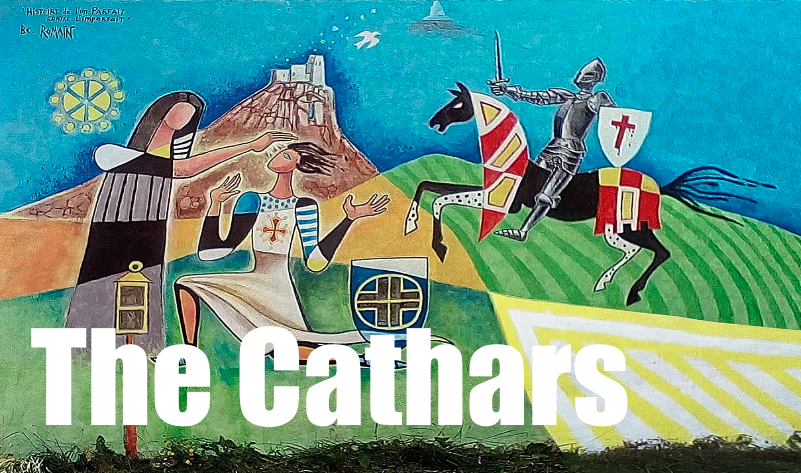By Danièle Cybulskie
Although the Catholic church reigned supreme in medieval Europe, it was by no means the only form that faith took at the time. Islam and Judaism were both practiced throughout Europe, and not every Christian agreed with the Catholic dogma they were taught in church. Although Protestantism was a few hundred years off, in the twelfth century another version of Christianity had a firm foothold in Europe with thousands upon thousands of followers, especially in southern France and Italy: Catharism.
Here is a quick, five-minute guide to one of the most popular spiritual movements of the Middle Ages.
1. Catharism was a dualistic faith.
Instead of accepting the Catholic church’s dogma involving the Holy Trinity, the Cathars believed that the universe was ruled by two gods in conflict: a good, kind, and loving god who had created the spiritual realm, and an evil god who had created this material, earthly world with all of its suffering. Cathars believed in Jesus as being this spiritual, benevolent god, and they adhered to the New Testament as their guide to living correctly. They rejected the humanity of Jesus, which put their faith in direct conflict with the eucharistic ideas of the Catholic church.
2. They were very accepting of women.
Cathars who wanted to be as spiritually pure as possible lived a strict life of celibacy, humility, and adherence to the bible, and were called perfecti. Much like Catholic priests, they ministered to their communities through preaching and a sort of baptism: a laying on of hands called consolamentum that was meant to elevate the regular Cathar to the level of perfecti and allow the person to ascend to heaven (like the Catholic last rites, consolamentum was usually administered near death for ordinary people).
However, there was one big difference between perfecti and priests: the Cathars allowed women to become perfectae with the same ability to teach and preach as the (male) perfecti. It’s estimated that the number of perfectae hovered around 50% (sometimes more, sometimes less), which indicates that Catharism was hugely attractive to – and accepting of – women. It would be naïve to assume absolute equality between men and women at this time; however, given that the Catholic church strictly prohibited women from nearly all positions of authority, Catharism must have seemed inviting, indeed.
3. They were vegetarian/vegan.
With the exception of fish, Cathar perfecti were expected to live on vegan fare, excluding eggs, cheese, and even the animal fat so often used in medieval cooking from their diets. (Their inclusion of fish likely stemmed from their devotion to the New Testament, as Jesus himself fed the multitudes with loaves and fishes.) Catholic monastic rules tended to limit or exclude meat, but they were not as strict with other animal products as were the Cathars.
4. Their faith was a rejection of – and reaction to – the Catholic church.
Medieval Christians of all sorts were uncomfortable with how the church was run, from its wealth and how it gathered it (for example, through the sale of indulgences) to its reliance on priests and Latin. In reaction to this, the Cathars ensured that perfecti had their own manual occupations in order to pay the bills. In this way, perfecti would not be tempted to sell their faith to support themselves. Perfecti also translated and preached in the vernacular (the language of the common people), making the words of the bible accessible to the people. This was an attractive idea, as the Catholic church required that the holy texts remained in Latin to be interpreted by priests. Catharism was thus aimed at breaking down these particular walls of elitism (although it did not concern itself with breaking down the walls between social classes).
5. They were subject to an official crusade, and effectively wiped out.
Although Catharism was decried as heresy in the twelfth century, it was in the early thirteenth century that Innocent III took the church’s rejection of Catharism to its most extreme. Now called the Albigensian Crusade (after the city of Albi, which was a target), the crusade against the Cathars was as brutal and bloody as the crusades in the Middle East – in fact, Innocent made this comparison explicit when he targeted them. Thousands of men, women, and children were slaughtered or burned as heretics in a bloodbath that officially lasted from 1209-1229, but unofficially continued until Catharism was effectively obliterated by the end of the century.
In perhaps the most brutal episode, the city of Béziers was besieged and sacked for refusing to surrender its Cathar citizens. It’s said that the papal legate told the crusaders: “Kill them all. God will recognize his own.” Somewhere between 9,000-20,000 citizens, Catholic and Cathar alike, were killed. The persecution of the Cathars was preached, among others, by St. Dominic, whose followers (the Dominican friars) would be frequently called upon to be the church’s inquisitors in heresy trials for centuries to follow. Some historians have set the total figure of Cathars killed over time at approximately one million.
For a look at the Cathars within the wider context of crusades, check out An Introduction to the Crusades by S.J. Allen. For Catharism within the context of women’s place in Christianity, see A Women’s History of the Christian Church: Two Thousand Years of Female Leadership by Elizabeth Gillian Muir. For a readable picture of the Albigensian Crusade, see Crusaders: The Epic History of the Wars for the Holy Lands by Dan Jones.
You can follow Danièle Cybulskie on Twitter @5MinMedievalist
Click here to read more articles from the Five-Minute Medievalist
Top Image: Les Cathares, by Bernard Romain / Wikimedia Commons
 https://www.medievalists.net/wp-content/uploads/2020/04/cathars-300x177.png 300w,
https://www.medievalists.net/wp-content/uploads/2020/04/cathars-300x177.png 300w, 













Pentru a putea adăuga comentarii trebuie să fii membru al altmarius !
Alătură-te reţelei altmarius